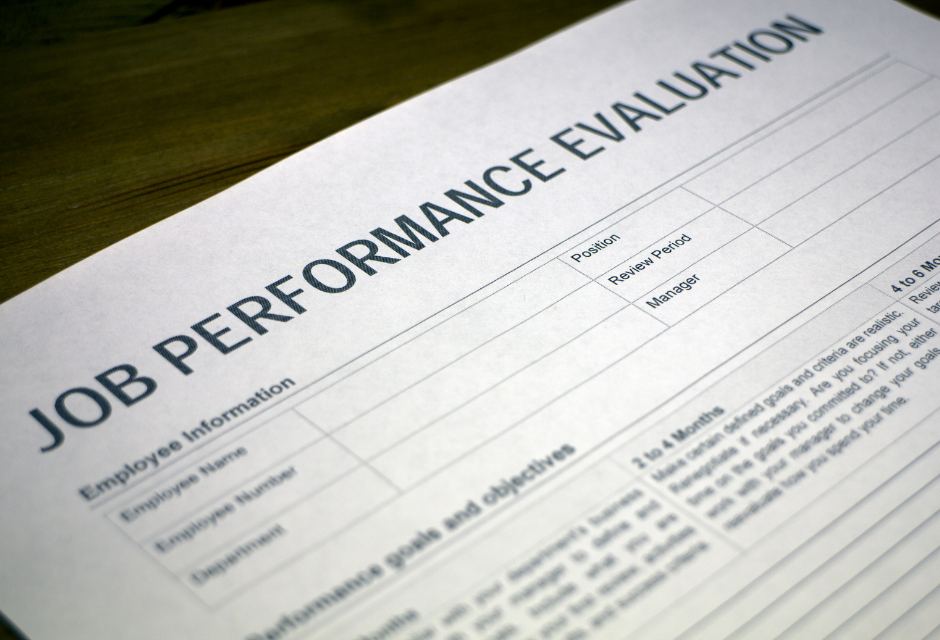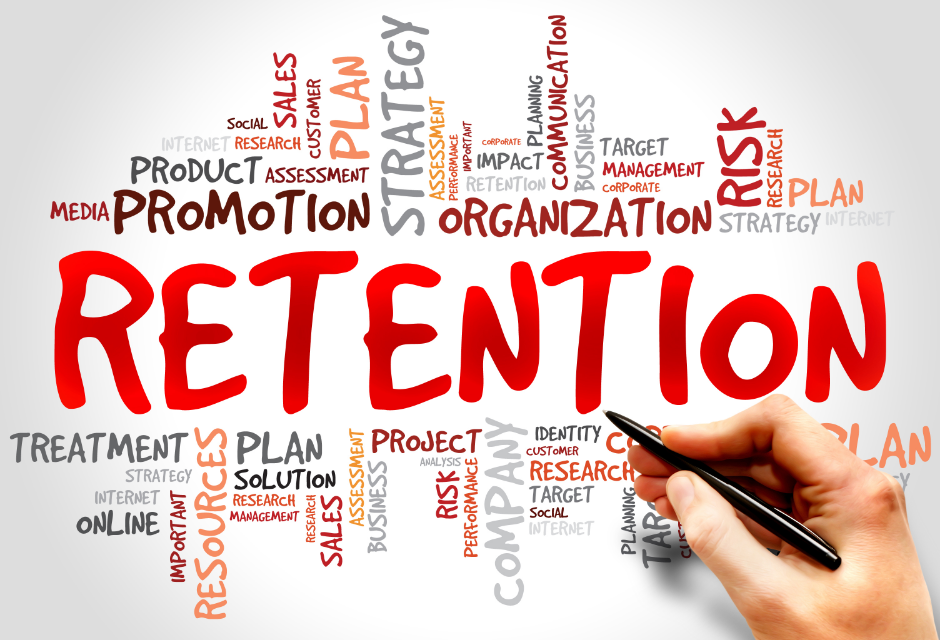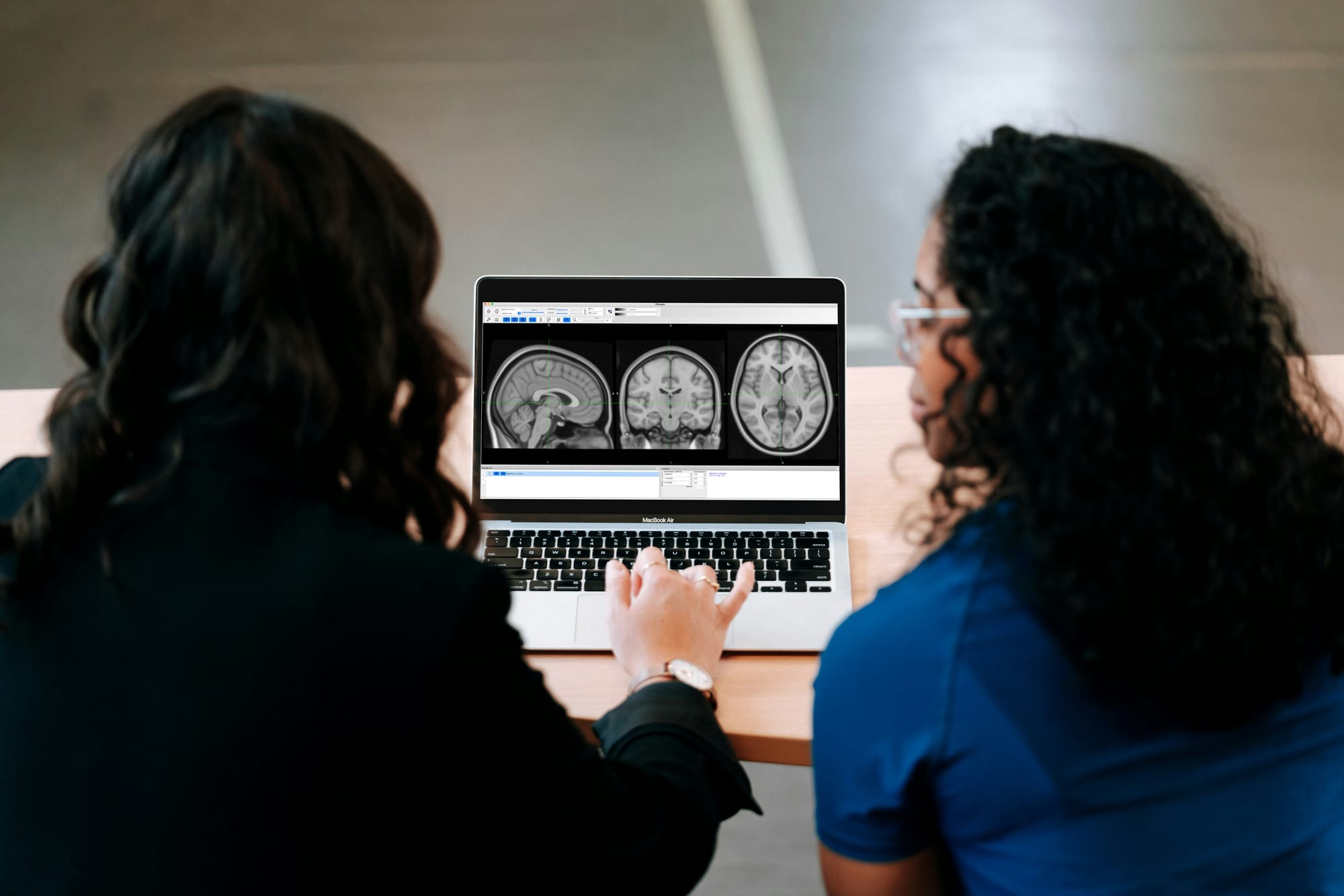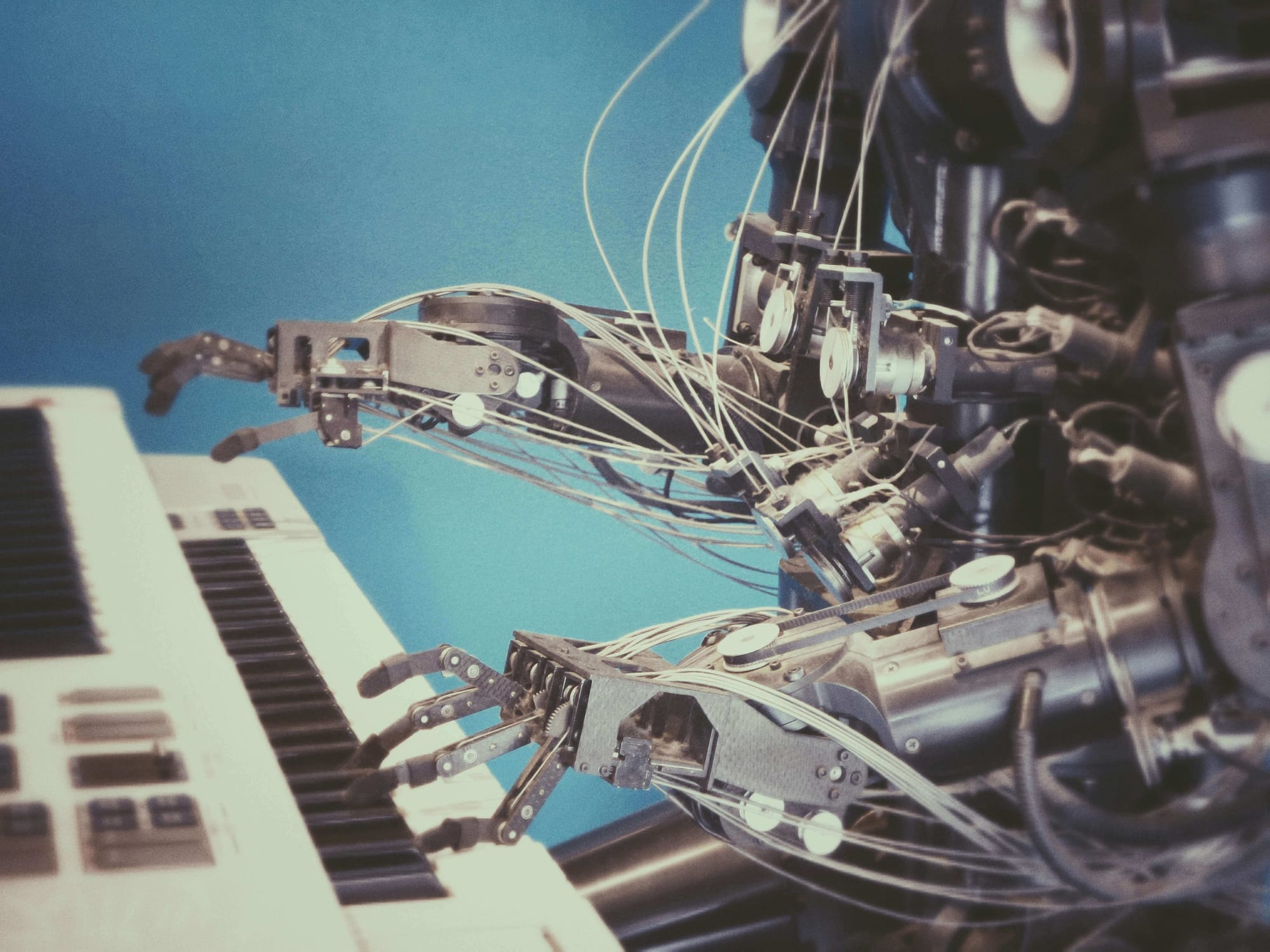What if your workforce was your biggest competitive advantage? The truth is, in today’s dynamic business landscape, companies that prioritize Human Capital Management (HCM) don’t just attract top talent—they retain, engage, and develop their workforce for long-term success. HCM is no longer just about HR processes; it’s a strategic approach to managing people as valuable assets that drive business growth.
At its core, HCM encompasses everything from recruitment and performance management to learning & development and workforce analytics. As businesses embrace digital transformation, modern HCM solutions leverage AI, automation, and cloud-based platforms to streamline HR operations.
The focus is shifting toward enhancing employee experience (EX), ensuring compliance, and aligning workforce capabilities with business objectives. A well-structured HCM strategy not only boosts productivity but also fosters a culture of continuous improvement and innovation.
One of the key enablers of effective HCM is ERP software that integrates HR functions with business processes. Deskera ERP provides a comprehensive HCM module that simplifies payroll, attendance tracking, performance evaluations, and compliance management—all within a single platform.
By leveraging automation and real-time analytics, Deskera helps businesses optimize workforce planning and decision-making, ensuring seamless HR operations.
In this complete guide, we will explore what HCM is, its key components, benefits, challenges, and future trends. We’ll also discuss how businesses can leverage technology and best practices to build a resilient, engaged, and high-performing workforce.
Whether you're a small business or an enterprise, understanding and implementing an effective HCM strategy can be a game-changer for your organization.
What is Human Capital Management (HCM)?
Human Capital Management (HCM) is a strategic approach to managing and developing employees, viewing them as valuable business assets rather than just operational costs.
It encompasses all aspects of workforce management, including recruitment, talent development, performance tracking, compensation, and employee engagement. The goal of HCM is to build a skilled, motivated, and high-performing workforce that drives business success.
HCM focuses on enhancing employee productivity and aligning workforce strategies with business objectives. This includes identifying skill gaps, implementing training programs, and ensuring employees are engaged and well-compensated.
Companies that adopt HCM strategies invest in their workforce through learning and development initiatives, career progression opportunities, and performance-based incentives, leading to better retention and long-term business growth.
Technology plays a key role in modern HCM, with specialized HCM software streamlining HR processes. These platforms integrate HRIS (Human Resource Information Systems), payroll management, workforce analytics, and performance tracking into a single system, helping businesses automate administrative tasks while gaining valuable insights into employee performance and engagement.
By implementing effective HCM practices, organizations create a strong company culture, improve employee satisfaction, and ultimately enhance business performance. Whether through recruiting top talent, tracking performance metrics, or fostering a culture of continuous learning, HCM is essential for businesses looking to maximize the potential of their workforce.
Key Components of Human Capital Management (HCM)
Effective Human Capital Management (HCM) comprises several essential components that ensure organizations attract, develop, and retain top talent while optimizing workforce productivity. These key components work together to create a seamless HR strategy that aligns employee performance with business goals.
1. Talent Acquisition & Recruitment
Finding and hiring the right talent is the foundation of HCM. An effective recruitment strategy ensures that organizations attract highly skilled professionals who fit their company culture and business needs.
Modern HCM solutions leverage AI-driven tools for resume screening, automated interview scheduling, and predictive analytics to enhance the hiring process.
2. Employee Onboarding
A structured onboarding process helps new hires integrate smoothly into the company, reducing time-to-productivity. Automated onboarding systems provide digital documentation, training schedules, and performance expectations, ensuring employees feel engaged and well-prepared from day one.
3. Performance Management
Tracking and improving employee performance is crucial for business success. HCM platforms provide real-time performance analytics, goal-setting tools, and 360-degree feedback systems to help organizations monitor productivity and support continuous growth. Regular performance reviews and feedback loops encourage employees to achieve their best.
4. Learning & Development (L&D)
Continuous learning and skill development are essential in today’s fast-changing work environment. L&D programs help employees upskill and reskill, ensuring they remain competitive and adaptable. HCM systems integrate e-learning platforms, training modules, and career development plans to enhance employee capabilities.
5. Compensation & Benefits
A well-structured compensation and benefits system is key to attracting and retaining top talent. HCM tools streamline payroll processing, incentive programs, bonuses, and benefits administration, ensuring fair and transparent salary structures while maintaining compliance with labor laws.
6. Workforce Planning & Analytics
Data-driven decision-making helps businesses forecast talent needs, analyze workforce trends, and optimize HR strategies. HCM systems provide real-time workforce analytics, predictive modeling, and scenario planning, enabling HR leaders to make informed decisions about hiring, restructuring, or employee development.
7. Employee Engagement & Retention
Engaged employees are more productive and loyal. HCM strategies focus on creating a positive work culture, fostering employee recognition programs, offering career growth opportunities, and maintaining a work-life balance. Tools like pulse surveys, feedback mechanisms, and employee wellness programs contribute to higher retention rates.
8. Succession Planning
To ensure business continuity, organizations must identify and develop future leaders. Succession planning helps businesses prepare high-potential employees for leadership roles through mentorship programs, leadership training, and internal promotions. HCM software assists in tracking leadership potential and career progression.
By integrating these key HCM components, businesses can create a high-performing, engaged, and future-ready workforce that drives long-term success.
The Role of Technology in Human Capital Management (HCM)
Technology has transformed Human Capital Management (HCM), making HR processes more efficient, data-driven, and employee-centric.
Modern HCM software solutions leverage AI, automation, and cloud computing to streamline recruitment, onboarding, performance management, and workforce planning.
By integrating advanced technologies, businesses can enhance employee experience, improve decision-making, and drive organizational success.
1. AI and Automation in HR Processes
Artificial Intelligence (AI) and automation have revolutionized HCM by eliminating repetitive tasks, enhancing talent acquisition, and improving workforce analytics.
AI-powered chatbots handle candidate inquiries, automated resume screening shortens recruitment cycles, and machine learning algorithms predict employee turnover, helping HR teams take proactive measures.
2. Cloud-Based HCM Solutions
Cloud-based HCM platforms provide businesses with real-time access to HR data, centralized workforce management, and remote accessibility. These solutions allow HR teams to manage payroll, attendance tracking, and compliance from anywhere, improving efficiency and collaboration across departments.
3. Workforce Analytics and Data-Driven Decision-Making
Advanced HCM tools use big data analytics and predictive modeling to offer deep insights into workforce trends, employee performance, and future talent needs. HR professionals can leverage these insights to identify skill gaps, optimize hiring strategies, and enhance employee engagement initiatives.
4. Employee Experience & Engagement Tools
Modern HCM platforms integrate engagement tools such as pulse surveys, real-time feedback, and gamification to foster a positive work environment. AI-driven sentiment analysis helps organizations understand employee satisfaction levels, enabling proactive strategies to boost morale and employee retention.
5. Learning and Development Through Digital Platforms
Technology-powered learning management systems (LMS) offer personalized training programs, online courses, and AI-driven career path recommendations. These systems help employees upskill and reskill efficiently, ensuring businesses maintain a highly skilled workforce in a rapidly evolving market.
6. Mobile Accessibility for a Flexible Workforce
With the rise of remote and hybrid work models, mobile-friendly HCM solutions allow employees to access HR services, track attendance, request leave, and complete training from their smartphones. This flexibility enhances employee convenience and ensures seamless workforce management.
7. Integration with Enterprise Systems
HCM software integrates with ERP, payroll, and customer relationship management (CRM) systems, ensuring smooth data flow across business functions. Platforms like Deskera ERP provide comprehensive HCM modules that simplify HR processes, automate payroll, and enhance workforce planning, contributing to overall business efficiency.
By leveraging technology in HCM, businesses can improve HR operations, create a data-driven workforce strategy, and build a more engaged and productive workforce. As technology continues to evolve, companies that embrace digital transformation in HCM will stay ahead in the competitive talent landscape.
Benefits of Implementing Human Capital Management (HCM)
A well-structured Human Capital Management (HCM) strategy helps organizations maximize employee potential while improving operational efficiency.
Implementing HCM solutions offers several key benefits, from streamlined HR processes to enhance employee engagement and long-term business success.
1. Improved Talent Acquisition and Retention
HCM ensures that companies attract, hire, and retain top talent by leveraging AI-driven recruitment, automated screening, and strategic workforce planning. By focusing on employee engagement, career development, and competitive compensation, businesses reduce turnover rates and build a more committed workforce.
2. Enhanced Employee Productivity
An effective HCM system provides real-time performance tracking, feedback mechanisms, and personalized learning opportunities, helping employees stay engaged and perform at their best. Automated HR processes also reduce administrative burdens, allowing HR teams to focus on strategic initiatives.
3. Streamlined HR Operations and Compliance
HCM solutions automate payroll, benefits administration, compliance tracking, and employee records management, reducing errors and ensuring adherence to labor laws and industry regulations. This minimizes compliance risks and improves operational efficiency.
4. Data-Driven Decision-Making
With AI-powered workforce analytics, businesses can gain insights into employee performance, productivity trends, and workforce planning. Predictive analytics help HR teams make informed decisions about hiring, promotions, succession planning, and training needs.
5. Cost Savings and Operational Efficiency
By automating repetitive HR tasks, businesses reduce administrative costs and optimize resource allocation. Cloud-based HCM solutions eliminate the need for manual data entry, excessive paperwork, and redundant processes, improving overall efficiency.
6. Enhanced Employee Engagement and Satisfaction
A positive employee experience leads to higher engagement and retention. HCM tools support real-time feedback, pulse surveys, wellness programs, and career development plans, fostering a more motivated and satisfied workforce.
7. Scalability and Flexibility for Growing Businesses
Cloud-based HCM solutions offer scalability, making it easy for businesses to adapt as they expand. Whether managing a small team or a global workforce, organizations can customize HR processes, integrate with other enterprise systems, and optimize workforce management efficiently.
8. Improved Learning and Development (L&D)
An effective HCM system facilitates employee training, upskilling, and career development through AI-driven learning management systems (LMS) and personalized career path recommendations. This ensures employees remain competitive and adaptable to evolving industry demands.
9. Better Succession Planning and Leadership Development
HCM tools help businesses identify high-potential employees, track leadership capabilities, and implement mentorship programs, ensuring smooth leadership transitions and a future-ready workforce.
10. Integration with Business Systems
HCM software seamlessly integrates with ERP, payroll, and workforce management systems, creating a unified HR ecosystem. Platforms like Deskera ERP provide comprehensive HCM modules for payroll, talent management, and workforce analytics, enhancing overall business efficiency.
By implementing a robust HCM strategy, organizations can enhance employee performance, drive workforce engagement, and achieve long-term business success while maintaining agility in a dynamic work environment.
Challenges in HCM Implementation
Implementing Human Capital Management (HCM) systems can drive efficiency and improve workforce management, but organizations often face challenges in adoption, integration, and execution. Understanding these hurdles can help businesses take proactive steps to ensure a successful HCM implementation.
1. Resistance to Change
Employees and HR teams may be reluctant to adopt new HCM systems due to fear of automation, unfamiliarity with new technologies, or concerns about job security. A well-planned change management strategy, including training and clear communication, is essential for smooth adoption.
2. Integration with Existing Systems
Many businesses use multiple HR, payroll, and enterprise resource planning (ERP) systems, making it difficult to integrate new HCM software. Ensuring seamless data migration and compatibility with existing platforms, like Deskera ERP, is crucial for operational efficiency.
3. Data Security and Compliance
Handling sensitive employee data comes with risks, including cybersecurity threats and regulatory compliance challenges. Organizations must ensure their HCM solutions comply with GDPR, HIPAA, and other labor laws while implementing robust data encryption and access controls.
4. High Implementation Costs
Deploying an HCM system requires investment in software, infrastructure, and training, which can be a significant challenge for small and mid-sized businesses. Companies should evaluate the long-term ROI of HCM solutions and explore scalable, cost-effective options like cloud-based platforms.
5. Lack of Skilled Workforce for HCM Management
HR teams may lack the technical expertise required to leverage HCM features effectively. Organizations must invest in training, upskilling HR professionals, and ensuring employees are proficient in using the system’s analytics, automation, and AI-powered tools.
6. Ensuring Employee Engagement
While HCM systems streamline HR operations, they must also enhance employee experience. If the platform is difficult to use or doesn’t provide engagement tools like feedback systems, learning modules, or career path tracking, employees may disengage, limiting the system’s effectiveness.
7. Managing Workforce Diversity and Remote Work Challenges
With businesses operating globally and across hybrid work models, HCM platforms must support multilingual capabilities, remote workforce management, and regional compliance regulations. Ensuring accessibility, mobile-friendliness, and real-time collaboration is key to overcoming these challenges.
8. Poorly Defined Goals and Metrics
Organizations sometimes implement HCM solutions without clearly defining their HR objectives, key performance indicators (KPIs), and expected outcomes. This leads to ineffective utilization of the platform and missed opportunities for workforce optimization.
9. Scalability and Future-Proofing
As businesses grow, their workforce needs evolve. If an HCM solution lacks scalability, it can become obsolete, requiring frequent upgrades or costly replacements. Organizations should invest in flexible, cloud-based HCM solutions that adapt to changing workforce dynamics.
10. Time-Consuming Implementation Process
HCM implementation can take months or even years, depending on organization size, customization needs, and integration complexities. To avoid delays, businesses should have a clear project roadmap, allocate dedicated resources, and ensure executive buy-in.
How to Overcome HCM Implementation Challenges
Successfully implementing Human Capital Management (HCM) solutions requires a strategic approach to address adoption barriers, ensure seamless integration, and maximize the system’s benefits.
Here are key strategies to overcome common HCM implementation challenges:
1. Develop a Strong Change Management Plan
Challenge: Resistance to change among employees and HR teams.
Solution:
- Communicate the benefits of HCM implementation early and clearly.
- Involve employees in the process through feedback sessions and pilot testing.
- Provide comprehensive training to familiarize staff with the new system.
- Appoint change champions within teams to drive adoption and encourage engagement.
2. Ensure Seamless Integration with Existing Systems
Challenge: Compatibility issues with HR, payroll, and ERP systems.
Solution:
- Choose an HCM solution that integrates with existing platforms, such as Deskera ERP, to ensure smooth data flow.
- Work with HCM vendors to customize integrations for optimal functionality.
- Conduct thorough testing before full deployment to detect and fix compatibility issues.
3. Strengthen Data Security and Compliance
Challenge: Protecting sensitive employee data and meeting regulatory requirements.
Solution:
- Select an HCM solution with strong encryption, access controls, and compliance features for GDPR, HIPAA, and labor laws.
- Train HR teams on data privacy best practices.
- Conduct regular security audits to prevent breaches.
4. Optimize Costs with a Scalable HCM Solution
Challenge: High implementation costs, especially for small businesses.
Solution:
- Opt for cloud-based HCM solutions to reduce infrastructure costs.
- Start with essential modules and gradually expand as the business grows.
- Calculate the long-term return on investment (ROI) by measuring efficiency gains and cost savings.
5. Upskill HR Teams for Better HCM Management
Challenge: Lack of technical expertise to manage HCM software.
Solution:
- Provide role-specific training for HR professionals on analytics, automation, and workforce management tools.
- Leverage AI-powered assistants, like Deskera’s AI-driven HR tools, to simplify decision-making.
- Encourage a culture of continuous learning through online training and certifications.
6. Enhance Employee Engagement with User-Friendly Tools
Challenge: Employees disengaging due to complex HCM platforms.
Solution:
- Choose an intuitive, mobile-friendly HCM platform with an engaging user experience.
- Implement self-service portals that allow employees to manage payroll, benefits, and career development easily.
- Utilize AI-driven HR chatbots for instant support and interaction.
7. Support Remote and Diverse Workforces
Challenge: Managing global and hybrid workforces effectively.
Solution:
- Use cloud-based HCM tools that support remote work and mobile access.
- Implement multilingual capabilities and localized compliance settings.
- Leverage AI-driven workforce analytics to optimize productivity across locations.
8. Define Clear Goals and Performance Metrics
Challenge: Lack of clear HR objectives leading to poor HCM utilization.
Solution:
- Set key performance indicators (KPIs) for talent acquisition, retention, and workforce productivity.
- Use real-time analytics and reports to track progress and make data-driven decisions.
- Regularly evaluate and adjust strategies based on workforce trends.
9. Choose a Future-Proof, Scalable HCM System
Challenge: Risk of the system becoming obsolete due to business growth.
Solution:
- Select a flexible, cloud-based HCM solution that scales with business needs.
- Partner with HCM vendors that offer regular updates and AI-driven enhancements.
- Ensure the system supports modular expansion to adapt to evolving workforce requirements.
10. Implement a Phased Rollout for Smooth Transition
Challenge: Long implementation timelines delaying benefits realization.
Solution:
- Start with a pilot phase in one department before full-scale deployment.
- Gather feedback from initial users and make improvements before wider implementation.
- Set realistic timelines and milestones to track progress and ensure accountability.
How to Choose the Right HCM Solution for Your Business
Selecting the right Human Capital Management (HCM) solution is a critical decision that can significantly impact the way you manage and develop your workforce.
With numerous HCM platforms available, each offering various features and functionalities, finding the best fit for your organization’s unique needs requires careful consideration.
Below are key factors to guide your selection process:
1. Identify Your Business Needs and Goals
Before diving into the technical aspects of an HCM solution, it’s crucial to understand your business goals and the specific needs of your workforce. Start by evaluating the pain points and challenges within your current HR processes.
Do you need a solution that focuses on talent acquisition, performance management, or employee engagement? Are you looking to streamline processes like payroll, benefits, or compliance? Establishing clear objectives will help narrow down which features and capabilities are essential for your organization.
2. Scalability and Flexibility
Your business needs an HCM solution that can scale as your organization grows. Look for platforms that offer flexibility in terms of features and customization. This is particularly important for companies that are expanding or operating in different regions.
Ensure the solution can accommodate your evolving workforce size and geographical locations, as well as adapt to your changing organizational needs. A good HCM system should grow with your business without requiring frequent upgrades or a complete overhaul of the software.
3. User-Friendly Interface
A user-friendly interface is essential for employee adoption and efficient use. HCM systems can be complex, but they should provide a seamless and intuitive user experience for both HR teams and employees.
Look for software that is easy to navigate, with clear dashboards, simple workflows, and accessible self-service features.
This will not only save time for HR departments but also ensure employees can interact with the system easily for tasks such as updating personal information, requesting time off, or accessing training resources.
4. Integration with Other Business Systems
A robust HCM solution should integrate easily with your organization’s existing tools and software. Whether it’s ERP systems, payroll software, or accounting platforms, the ability to integrate with other business-critical applications ensures smooth data flow and reduces the need for manual intervention.
Ensure the HCM platform supports integration with tools your business already uses, whether through APIs or built-in connectors. This will help create a unified ecosystem that minimizes errors and enhances productivity across departments.
5. Comprehensive Analytics and Reporting
An effective HCM solution should provide data-driven insights into your workforce’s performance, engagement, and productivity. Look for software that offers comprehensive analytics tools, allowing you to track key metrics such as employee performance, turnover rates, training completion, and compensation trends.
With detailed reporting capabilities, HR teams can make more informed, strategic decisions about talent management and development. The ability to analyze data from various aspects of the employee lifecycle can help identify areas for improvement and ensure your business is operating at peak efficiency.
6. Cost and ROI
The cost of HCM solutions can vary significantly depending on the features, scalability, and number of users. Consider your budget and assess the return on investment (ROI) of the system.
While some HCM systems may come with a higher initial investment, they might save you money in the long run by improving operational efficiency, reducing turnover, or enhancing recruitment.
Be sure to evaluate pricing structures (subscription-based, one-time payment, per-user pricing) and select a solution that aligns with your budget while providing the necessary features for your organization’s growth.
7. Vendor Reputation and Customer Support
It’s important to partner with a reputable HCM provider that has a proven track record in delivering quality software and customer support. Research the vendor’s reputation, read customer reviews, and check out case studies or client testimonials to gauge their reliability and performance.
Moreover, consider the level of customer support provided by the vendor. Look for providers who offer 24/7 support, user training, and resources such as FAQs, forums, and knowledge bases to ensure your team can effectively use the system and resolve issues promptly.
8. Compliance and Security Features
Given the sensitivity of employee data, data security and compliance should be top priorities when selecting an HCM solution. Ensure the platform adheres to industry standards and regulations such as GDPR or HIPAA to protect personal information.
Look for strong security measures such as data encryption, multi-factor authentication, and regular system updates to protect your data from breaches.
Additionally, the HCM solution should include tools to help you maintain compliance with local labor laws, tax regulations, and other legal requirements related to employee management.
9. Mobile Accessibility
In today’s mobile-driven world, it’s essential to choose an HCM solution that offers mobile accessibility. With employees working from different locations and using various devices, a mobile-optimized platform allows HR teams and employees to access information and complete tasks on the go.
Whether it’s reviewing payslips, updating personal details, or submitting performance reviews, mobile functionality ensures that all aspects of human capital management are accessible at any time and from any place, increasing employee engagement and efficiency.
10. Customization and Future-Proofing
As your organization evolves, your HCM solution should be adaptable to future needs. Customization options allow you to tailor the system to meet your specific business processes, rather than having to change how your business operates to fit the software.
Look for solutions that provide flexibility in configuring workflows, fields, and reports. Additionally, future-proofing is crucial; opt for solutions that offer continuous updates and enhancements to stay in line with industry trends, technology advancements, and changing employee expectations.
Future Trends in Human Capital Management (HCM)
As the business landscape evolves, so too does Human Capital Management (HCM). Emerging trends reflect the growing need for advanced technology, employee-centric practices, and data-driven strategies to manage talent, performance, and organizational growth.
Below are some key future trends shaping the HCM landscape:
1. AI and Automation in Recruitment and Talent Management
Artificial intelligence (AI) is increasingly being used to automate recruitment, identify top talent, and streamline performance management processes. AI-driven tools can scan resumes, assess candidate fit through data analysis, and even help with predictive talent management by identifying employees who are likely to succeed or leave.
By incorporating AI in talent acquisition and retention, businesses can reduce human bias and make more informed decisions, speeding up hiring processes and improving workforce quality.
2. Data-Driven Decision-Making with Workforce Analytics
The future of HCM lies in data-driven decision-making. With the help of advanced analytics tools, organizations are tapping into the power of big data to gain insights into employee behavior, performance metrics, and productivity trends.
Workforce analytics will play a pivotal role in optimizing hiring strategies, identifying skill gaps, forecasting staffing needs, and improving overall workforce efficiency.
With the right tools, companies can drive better employee engagement, retention, and performance, enabling them to align their human capital strategy with business goals.
3. Cloud-Based HCM Solutions
The demand for cloud-based HCM platforms continues to grow as businesses move away from legacy systems. Cloud solutions offer the flexibility, scalability, and cost-effectiveness needed to manage dynamic, global workforces.
These systems also allow for real-time updates, mobile accessibility, and data integration across different HR functions, from recruitment to payroll and performance management.
Cloud-based platforms enable businesses to quickly adapt to new trends and stay competitive in a rapidly changing market.
4. Focus on Employee Experience and Well-Being
Future HCM strategies will emphasize employee experience as a core component of business success. As organizations recognize the importance of mental health, work-life balance, and overall employee well-being, they are incorporating employee-centric policies into their HR strategies.
This includes flexible work schedules, health and wellness programs, and the use of AI-powered tools for personalized career development.
HCM platforms will become increasingly integrated with employee engagement tools that allow organizations to track satisfaction, gather feedback, and offer solutions to enhance employee experiences.
5. Gig Economy and Workforce Flexibility
The gig economy is expected to expand as more individuals opt for flexible, freelance, and contract work. This shift in the workforce structure is prompting HCM platforms to adapt to the needs of a hybrid workforce that includes full-time employees, part-timers, freelancers, and contractors.
As businesses adjust to this change, HCM systems will need to support dynamic workforce management, including compliance management, payroll processing, and onboarding for non-traditional workers. Flexibility, scalability, and efficiency will be key in accommodating a diverse talent pool in a post-pandemic world.
6. Continuous Learning and Upskilling
With the rapid pace of technological advancements, employees must continuously upgrade their skills. Lifelong learning and upskilling programs will become more integrated into HCM strategies as companies aim to keep their workforce adaptable to new technologies and evolving industry demands.
HCM systems will feature personalized learning paths using AI and machine learning to suggest relevant courses and certifications for each employee. By prioritizing learning, businesses can develop a future-ready workforce that is prepared to meet both current and future challenges.
7. Diversity, Equity, and Inclusion (DEI) Initiatives
Diversity, equity, and inclusion will continue to be a driving force in the future of HCM. Organizations are investing more in inclusive hiring practices, creating diverse teams, and implementing policies to foster a sense of belonging at work.
HCM platforms will incorporate DEI analytics to measure progress, track hiring diversity, and assess employee experiences across different demographic groups. These tools will help companies build equitable work environments, address bias, and ensure fair treatment for all employees.
8. Employee Self-Service and Personalization
HCM systems are moving toward more employee-driven solutions, offering self-service features that allow individuals to manage their own data, request time off, review performance feedback, and access learning resources.
With the rise of personalization, these systems will be designed to meet the specific needs of each employee, offering tailored recommendations for training, career growth, and compensation.
The integration of AI-powered chatbots and virtual assistants will also provide employees with on-demand support for HR-related queries.
9. Blockchain for Payroll and Compliance
As organizations handle increasing amounts of sensitive employee data, blockchain technology is poised to offer a more secure and transparent way to manage payroll, tax compliance, and employee records.
By using blockchain, organizations can reduce the risk of fraud, ensure accurate and transparent payments, and streamline regulatory compliance processes.
This technology will improve the efficiency and security of HR operations, especially in global businesses dealing with cross-border payroll and complex compliance requirements.
10. Predictive Analytics for Talent Management
Predictive analytics will help organizations anticipate future workforce needs, such as predicting employee turnover, performance trends, and succession planning.
By leveraging historical data, businesses can forecast skill shortages, identify high-potential employees, and take proactive steps to manage talent pipelines effectively.
HCM platforms will integrate predictive tools that allow HR teams to plan for the future and make informed decisions regarding staffing, training, and promotion opportunities.
How Deskera ERP Enhances Human Capital Management (HCM)
Managing human capital effectively is crucial for business success, and Deskera ERP provides a comprehensive HR management solution to help businesses streamline their HR operations.
With automation, real-time tracking, and powerful analytics, Deskera ERP simplifies workforce management while ensuring compliance with local and national regulations.
Here’s how Deskera ERP can optimize your HCM processes:
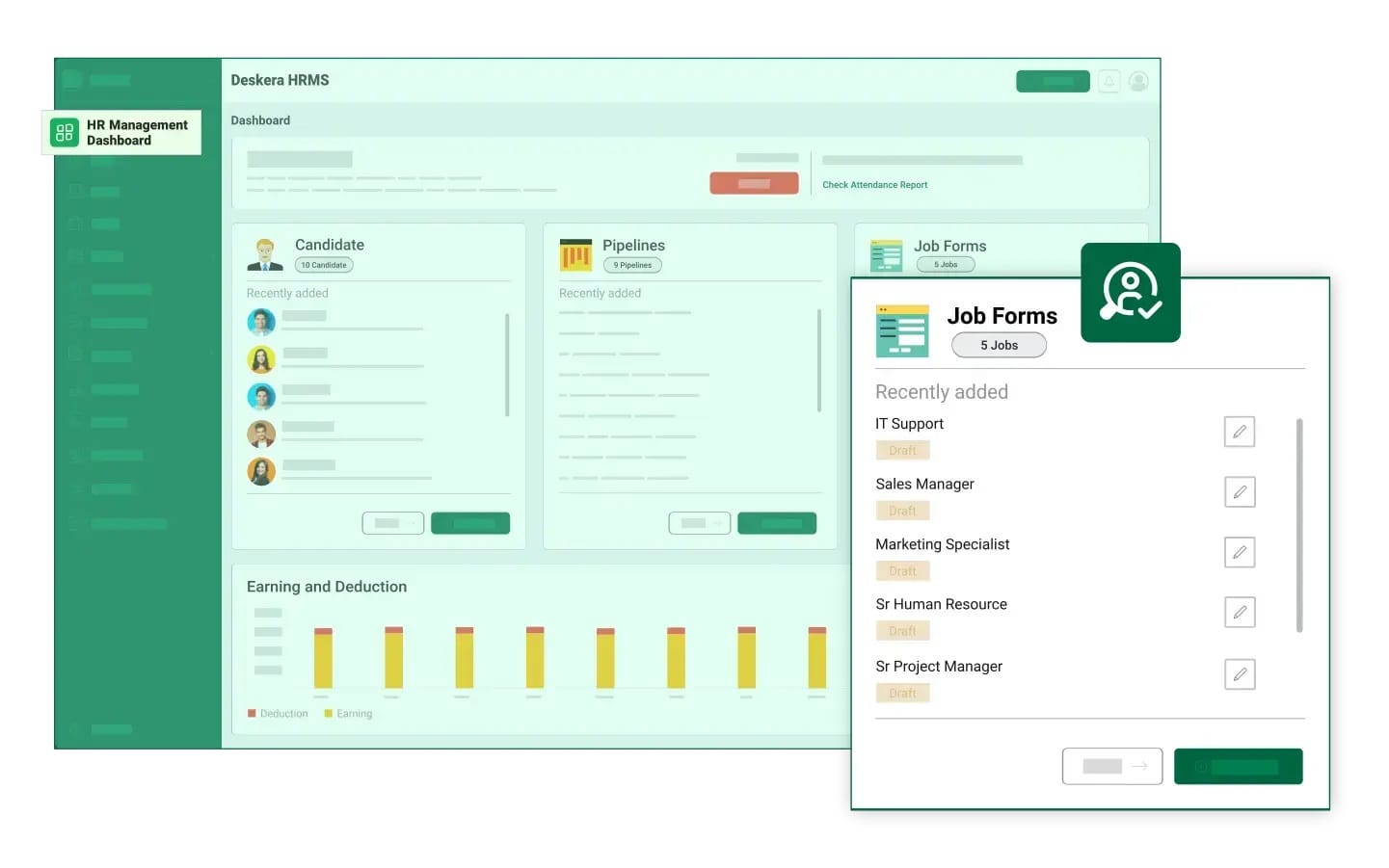
1. Streamlined Recruitment & Onboarding
- Automate job postings and track applications efficiently.
- Enhance the candidate experience with personalized automated communication.
- Use AI-driven assessments to make data-backed hiring decisions.
- Maintain a centralized employee database for easy access to records.
2. Efficient Payroll & Benefits Management
- Automate payroll calculations for accuracy and compliance.
- Seamlessly reconcile payroll with bank statements.
- Generate detailed payroll reports including tax deductions and salary history.
- Manage employee benefits, bonuses, and incentives with ease.
3. Attendance & Leave Tracking
- Automate timesheet tracking for better workforce planning.
- Monitor employee hours, overtime, and absences in real-time.
- Enable employees to submit leave requests digitally, reducing paperwork.
4. Performance & Employee Engagement
- Track and measure employee performance goals with real-time insights.
- Assign tasks, monitor progress, and document performance reviews.
- Optimize employee engagement with customized dashboards and feedback tools.
5. Claims & Expense Management
- Automate claims approval for faster reimbursements.
- Track employee expenses in real time to control costs.
- Generate detailed expense reports to analyze spending patterns.
6. Advanced Reporting & Analytics
- Generate intuitive HR reports to analyze workforce trends.
- Customize dashboards for a comprehensive HR overview.
- Ensure compliance with labor laws using automated notifications & alerts.
7. Secure Access & System Integration
- Integrate seamlessly with existing business systems.
- Customize roles & permissions for secure employee data access.
- Ensure data protection with secure, cloud-based HR management.
Key Takeaways
- HCM is a strategic approach to managing and developing employees as valuable business assets, ensuring productivity, engagement, and long-term organizational success.
- HCM encompasses various HR functions, including talent acquisition, onboarding, performance management, learning & development, payroll, workforce planning, and succession planning, to build a strong workforce.
- Digital tools and HCM software automate HR processes, enhance decision-making through analytics, and improve efficiency, making human resource management more strategic and data-driven.
- Implementing a robust HCM strategy improves employee engagement, productivity, retention, compliance, and workforce optimization, driving overall business performance.
- Common challenges include resistance to change, data security concerns, system integration issues, and high implementation costs, requiring careful planning and execution.
- The right HCM solution should align with business goals, be user-friendly, offer automation, provide real-time insights, and ensure compliance, while also being scalable for future needs.
- Businesses can address challenges by choosing scalable solutions, providing adequate training, ensuring data security, and integrating HCM with existing business systems for a smooth transition.
- Emerging trends such as AI-driven HR processes, predictive analytics, remote workforce management, and employee experience platforms are shaping the future of HCM.
- Deskera ERP’s HR management tools empower businesses to automate and optimize every aspect of HCM, from hiring to payroll, performance tracking, and compliance. By using Deskera, companies can reduce manual effort, enhance efficiency, and improve employee satisfaction—all while ensuring smooth and compliant HR operations.
Related Articles


